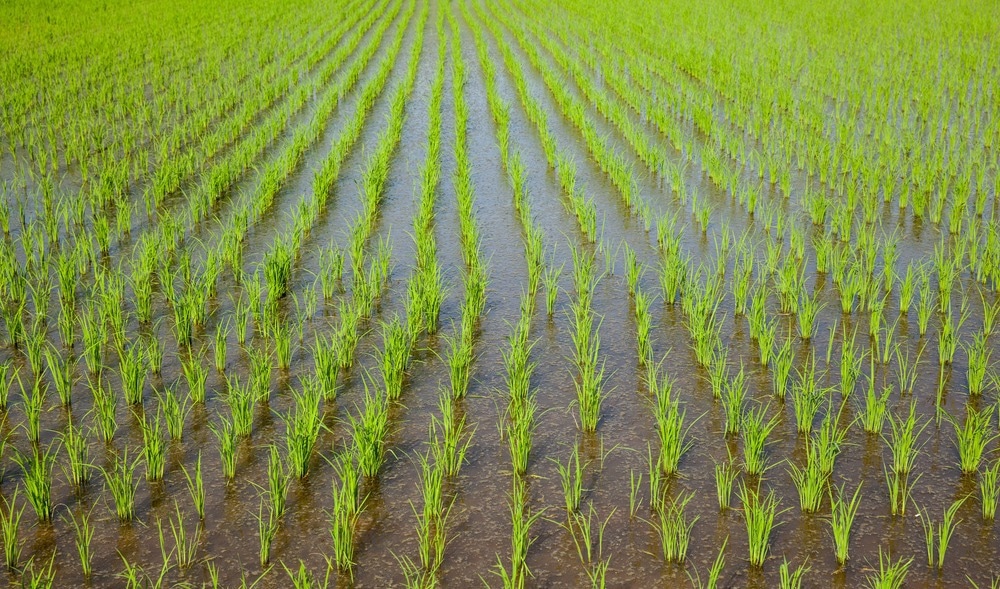The bacterial strain Xanthomonas oryzae pv.oryzae (Xoo), which causes bacterial leaf blight (BLB) infection, significantly impacts rice yield. Nano-enabled techniques have lately gained popularity as a long-term framework for improving crop nutrition and inhibiting plant diseases.

Study: Bioengineered chitosan-iron nanocomposite controls bacterial leaf blight disease by modulating plant defense response and nutritional status of rice (Oryza sativa L.). Image Credit: pran/Shutterstock.com
The production and characterization of bioengineered chitosan iron nanocomposites (BNCs) as an antibacterial agent for treating bacterial leaf blight infection in rice crops is the topic of a new study published in the journal Nano Today.
Microbial Infections: A Significant Threat to Rice Crops
Rice is an essential food crop on a global scale. The worldwide population is expected to grow from 7 to 9 billion by 2050, emphasizing the need to increase rice output to ensure global food sustainability.
Rice yields, however, are challenged by a variety of biotic stressors, including microbial diseases, predatory insects, and weeds. The pathogen Xanthomonas oryzae pv. oryzae (Xoo) causes bacterial leaf blight (BLB) illness and is one of the most damaging infections restricting rice output in South Asian nations.
Traditional BLB control solutions include antibiotics and chemical-based medicines, which are costly, detrimental to public health, environmentally destructive, and may lead to pathogen resilience. Furthermore, generating BLB-resistant rice genotypes via traditional breeding or genetic modification is difficult and time-consuming.
As a result, novel BLB disease management techniques are urgently needed to boost rice yield and reduce food insecurity.
Nano-Enabled Agrochemicals for Plant Disease Management
Nano-enabled agrochemicals are gaining popularity for future uses in plant protection as long-term alternatives to traditional pest control methods.
According to several studies, nanocomposites improve plant disease resistance by enhancing plant development, physiological responses, photosynthetic efficiency, nutritional content, and hormone composition. The controlled application of nanoscale micronutrients can increase agricultural productivity by modifying plant health and providing pathogens management.
Many researchers have recently concentrated on adding nanoparticles into biopolymer matrices to create nanocomposites with novel characteristics that can be modified to regulate analyte release.
Novel Bioengineered Chitosan Iron Nanocomposites (BNCs)
Chitosan is a biopolymer with distinct qualities such as nontoxicity, good biocompatibility, immunogenicity, and antibacterial capabilities. Chitosan can directly enhance plant development via antibacterial action and systemic resistance through the octadecanoid channel.
Furthermore, chitosan can be employed as a supporting matrix for metallic nanocomposites, resulting in better physicochemical durability, targeted micronutrient distribution, cytocompatibility, and good antimicrobial activities.
Although the production of chitosan-based engineered nanomaterials (ENMs) has been studied for a variety of applications, the current study introduces a green manufacturing process for the production of bioengineered chitosan iron nanocomposites (BNCs) utilizing the bacterial strain Bacillus aryabhattai RNT7.
Furthermore, this is the first description of in vitro and in vivo analysis of bio-engineered nanocomposites' bactericidal effectiveness against Xoo. A high-throughput amplicon sequencing technique was utilized in the research to examine the influence of bio-engineered nanocomposites on the endophytic microbial content of healthy and damaged rice plants.
Key Developments of the Study
The findings show that foliar treatment of bio-engineered nanocomposites significantly suppresses BLB illness via various processes, including control of cellular functions, modulation of nutrient uptake, and activation of defense-related genes.
The ultrastructure analysis revealed that bio-engineered nanocomposites greatly reduce BLB-induced stress by limiting the growth of the Xoo infection. The transcription of pathogenesis-related genes was elevated in Xoo-infected rice crops after BNCs administration, demonstrating the beneficial effect of bio-engineered nanocomposites on rice crops.
The high-throughput sequencing results showed that exposing rice plants to bio-engineered nanocomposites greatly decreases the frequency of the Xoo infection. A favorable endophytic bacterial community composition was also maintained in the rice crops.
Future Outlook
Investigating the basic processes of BNC-mediated plant microbiological community management is an intriguing future problem that will contribute to our knowledge of appropriate strategies for developing desired bacterial communities while hindering the impact of plant pathogens.
The current findings show that foliar spraying of bio-engineered nanocomposites has promising results as a new technique for BLB disease control. This study also provides a molecular framework for assessing the influence of bio-engineered nanocomposites on rice endophytic microbial populations as part of green nano-enabled agriculture.
Reference
Ahmed, T. et al. (2022). Bioengineered chitosan-iron nanocomposite controls bacterial leaf blight disease by modulating plant defense response and nutritional status of rice (Oryza sativa L.). Nano Today. Available at: https://www.sciencedirect.com/science/article/pii/S174801322200175X?via%3Dihub
Disclaimer: The views expressed here are those of the author expressed in their private capacity and do not necessarily represent the views of AZoM.com Limited T/A AZoNetwork the owner and operator of this website. This disclaimer forms part of the Terms and conditions of use of this website.